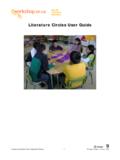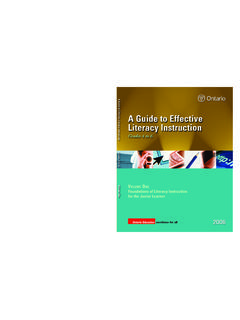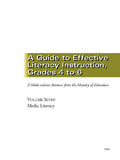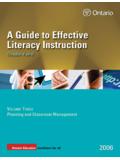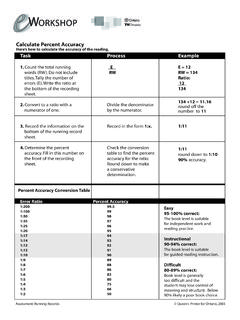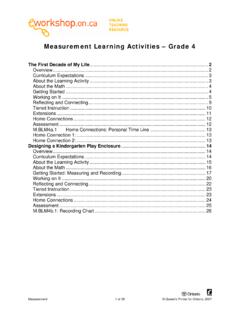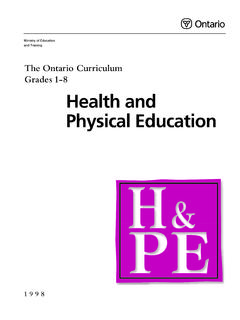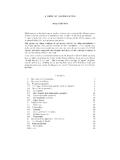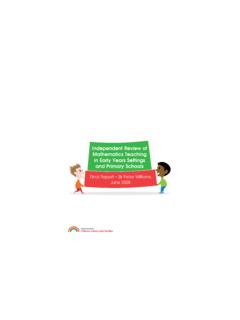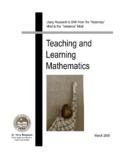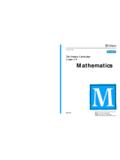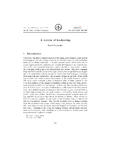Transcription of A Guide to Effective Instruction in Mathematics
1 A Guide to Effective Instruction in Mathematics Kindergarten to Grade 6. A Resource in Five Volumes from the Ministry of Education Volume Two Problem Solving and Communication Every effort has been made in this publication to identify Mathematics resources and tools ( , manipulatives) in generic terms. In cases where a particular product is used by teachers in schools across Ontario, that product is identified by its trade name, in the interests of clarity. Reference to particular products in no way implies an endorsement of those products by the Ministry of Education. Une publication quivalente est disponible en fran ais sous le titre suivant : Guide d'enseignement efficace des math matiques, de la maternelle la 6e ann e. Contents Introduction .. v 5. Problem Solving .. 1. Introduction .. 3. Teaching Through Problem Solving .. 7. Teaching About Problem Solving.
2 34. Observing Students and Assessing Their Work as They Solve Problems .. 48. Appendix .. 51. 6. Communication .. 53. Introduction .. 55. Communication in the Classroom .. 58. Oral Communication .. 66. Written Communication .. 70. Questions and Prompts for Promoting Communication .. 80. References .. 85. Introduction This is Volume Two of the five-volume reference Guide A Guide to Effective Instruction in Mathematics , Kindergarten to Grade 6. This volume includes Chapters 5 and 6. Chapter 5: Problem Solving focuses on the most Effective method for developing and consolidating students' understanding of mathematical concepts in the primary and junior grades that of teaching both through problem solving and about problem solving. Chapter 6: Communication emphasizes the importance of promoting oral communication about Mathematics in the primary and junior grades, and describes a number of cross-curricular literacy strategies that foster math talk and, later, math writing in the classroom.
3 (See the Introduction of Volume One for a summary of the organization and contents of the complete five-volume Guide .). A list of suggested professional resources for teachers and administrators is included in Volume One. It is meant to provide useful suggestions, but should not be consid- ered comprehensive. A glossary of terms used throughout the Guide is also provided at the end of Volume One. References are listed at the end of each individual volume. This Guide contains a wide variety of forms and blackline masters, often Go to for electronic versions of the provided in appendices, that teachers can use in the classroom. Electronic forms and blackline masters versions of all of these materials can be found at provided throughout this These electronic forms and blackline masters are in a Word format that Guide . They can be modified can be modified by teachers to accommodate the needs of their students.
4 To meet classroom needs. Locating Information Specific to Kindergarten, Primary, and Junior K Kindergarten Students in This Guide 1 3 Primary An important feature of this Guide is the inclusion of grade-related 4 6 Junior information and examples that help clarify the principles articulated. Such information is identified in the margins of this Guide by means of Look for the following icons in icons referring to the relevant grades K for Kindergarten, Grades 1 3 the margins of this document: for primary, Grades 4 6 for junior. Examples and other materials that are appropriate for use at more than one level or are applicable to more than one level are identified by the appropriate combination of icons. v 5. Chapter Contents Problem Solving Introduction .. 3. The Importance of Problem Solving .. 3. Instructional Implications of Teaching Through and About Problem Solving.
5 6. Teaching Through Problem Solving .. 7. What Teaching Through Problem Solving Looks Like .. 9. Problem-Solving Vignette Grade 1 .. 10. Getting Started .. 10. Working on It .. 12. Reflecting and Connecting .. 14. Problem-Solving Vignette Grade 4 .. 18. Getting Started .. 18. Working on It .. 20. Reflecting and Connecting .. 22. The Teacher's Role in Teaching Through Problem Solving .. 26. Providing Appropriate and Challenging Problems .. 26. Supporting and Extending Learning .. 29. Encouraging and Accepting Students' Strategies .. 31. Questioning and Prompting Students .. 32. Using Think-Alouds .. 34. Teaching About Problem Solving .. 34. Classroom Structures That Support Problem Solving .. 35. The Four-Step Problem-Solving Model .. 36. Problem-Solving Strategies .. 38. The Teacher's Role in Teaching About Problem Solving .. 44. Helping to Develop Strategies.
6 44. Choosing Problems .. 45. Problem Posing .. 46. Observing Students and Assessing Their Work as They Solve Problems .. 48. Appendix Appendix 5 -1: Problem-Solving Tracker .. 51. 2 A Guide to Effective Instruction in Mathematics , Kindergarten to Grade 6 Volume Two Problem Solving Introduction THE IMPORTANCE OF PROBLEM SOLVING. An information- and technology-based society requires individuals who are able to think critically about complex issues, people who can Problem solving is not only a analyze and think logically about new situations, devise unspecified goal of learning Mathematics solution procedures, and communicate their solution clearly and but also a major means of convincingly to others (Baroody, 1998, p. 2-1). To prepare students doing so.. to function in such a society, teachers have a responsibility to promote (NCTM, 2000, p. 52). in their classrooms the experience of problem-solving processes and the acquisition of problem-solving strategies, and to foster in students positive dispositions towards problem solving.
7 In promoting problem solving, teachers encourage students to reason their way to a solution or to new learning. During the course of this problem solving, teachers further encourage students to make conjectures and justify solutions. The communi- cation that occurs during and after the process of problem solving helps all students to see the problem from different perspectives and opens the door to a multitude of strategies for getting at a solution. By seeing how others solve a problem, students can begin to think about their own thinking (metacognition) and the thinking of others and can consciously adjust their own strategies to make them as efficient and accurate as possible. 3. In their everyday experiences, students are intuitively and naturally solving problems. They seek solutions to sharing toys with friends or building elaborate structures with construction materials.
8 Teachers who use problem solving as the focus of their mathe- matics class help their students to develop and extend these intuitive strategies. Through relevant and meaningful experiences, students develop a repertoire of strate- gies and processes ( , steps for solving problems) that they can apply when solving problems. Students develop this repertoire over time, as they become more mature in their problem-solving skills. The problem-solving processes that Kindergarten students use will look very different from those that Grade 6 students use. Initially, students will rely on intuition. With exposure, experience, and shared learning, they will formalize an Effective approach to solving problems by developing a repertoire of problem-solving strategies that they can use flexibly when faced with new problem- solving situations. In fostering positive dispositions in their students towards problem solving, teachers deal with the affective factors that have an impact on student behaviour in both positive and negative ways (Schoenfeld, 1992).
9 Students who believe that they are good problem solvers are not apt to give up after a few minutes when faced with a challenging problem. Because beliefs influence behaviour, Effective Mathematics programs always consider students' beliefs and attitudes, and teachers work to nurture in students confident attitudes about their abilities as mathematical problem solvers and their beliefs that everyone can make sense of and do Mathematics . As students engage in problem solving, they participate in a wide variety of cognitive experiences that help them to prepare for the many problem- We want children to solving situations they will encounter throughout their lives. They: take risks, to tackle unfamiliar tasks, and to learn mathematical concepts with understanding and practise skills stick with them in short, in context;. to try and persevere. reason mathematically by exploring mathematical ideas, making con- We want children to be jectures, and justifying results; flexible in their thinking reflect on the nature of inquiry in the world of Mathematics ; and to know that many reflect on and monitor their own thought processes; problems can be modeled, represented, and solved select appropriate tools ( , manipulatives, calculators, computers, in more than one way.)
10 Communication technology) and computational strategies;. (Payne, 1990, p. 41). make connections between mathematical concepts;. connect the Mathematics they learn at school with its application in their everyday lives;. develop strategies that can be applied to new situations;. represent mathematical ideas and model situations, using concrete materials, pictures, diagrams, graphs, tables, numbers, words, and symbols;. 4 A Guide to Effective Instruction in Mathematics , Kindergarten to Grade 6 Volume Two go from one representation to another, and recognize the connections between representations;. persevere in tackling new challenges;. formulate and test their own explanations;. communicate their explanations and listen to the explanations of others;. participate in open-ended experiences that have a clear goal but a variety of solution paths;. collaborate with others to develop new strategies.
